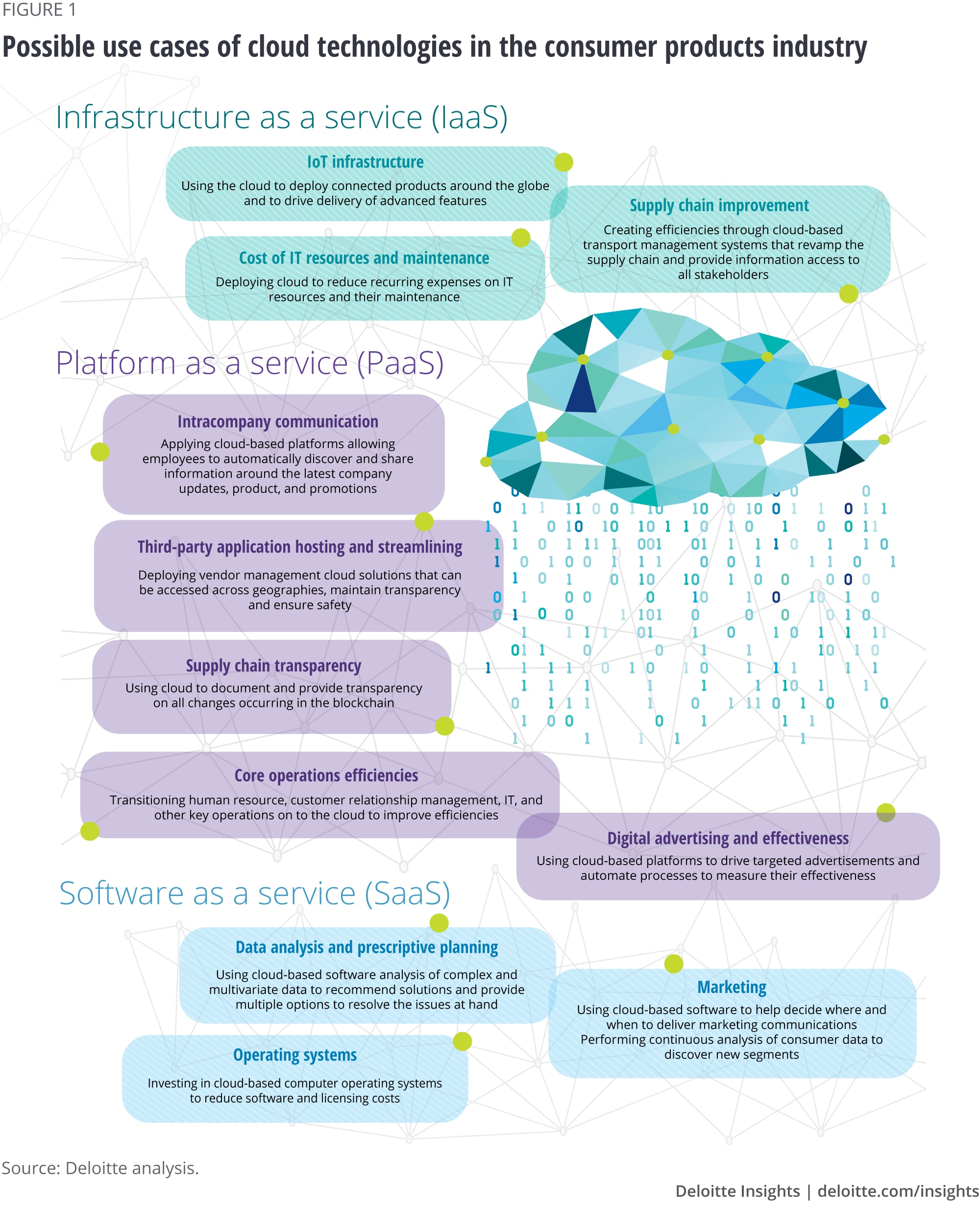
The adoption of disruptive technologies in the consumer products industry Spotlight on the cloud
6 minute read
04 April 2019
Cloud solutions help consumer product companies inform their strategies by deploying nimble processes and analytics with faster and more precise scalability.
Predictive analytics. Data mining. Deeper customer engagement through multilingual, omnichannel customer relationship management platforms. Speed. Cost savings. These are a few of the techniques and benefits made possible by cloud solutions. With the widespread adoption of cloud technologies over the past decade, businesses have rapidly transformed their operations while driving cost efficiencies, whereas, in the past they spent a substantial amount of time, money, and resources to scale their operations across markets.
Learn more
View the Disruptive technologies in consumer products series
View the infographic on the Disruptive consumer product technologies
Explore the Retail & consumer products collection
Subscribe to receive related content
Today, cloud technologies enable ubiquitous, convenient, on-demand network access to a shared pool of configurable computing resources, such as networks, servers, storage, applications, and services, which can be quickly provisioned and released with minimal management effort.1 As cloud technologies are continually being refined, they can offer numerous benefits to both consumer products companies and their consumers. Further, they can create an enabling environment for the smooth execution of other disruptive technologies that have been discussed in the other articles in this series.
For example, in our discussion on blockchain technology, we noted how Cargill used blockchain technology to individually trace its Thanksgiving turkeys. The technology used for implementing this was deployed on a cloud-based system.2 Similarly, when we discussed artificial intelligence, we delved into the use of machine learning to analyze big data and apply tools and techniques of predictive analytics, such as data mining, modeling, and advanced statistics.3 These machine learning tools are enabled by cloud technologies.
Consumer products companies and cloud technologies
Consumer products companies began their journey of adopting cloud technologies more than a decade ago, and they continue to apply them to further simplify information technology (IT) operations and drive standardization.4 More specifically, by using the cloud, companies can reap the benefits of:
- Rapid implementation of hardware and software: Less time is required by companies to activate and scale hardware and software operations using cloud-based systems.
- Quick returns: Investments in cloud platforms facilitate accelerated implementation and eliminate upfront licensing and infrastructure costs, resulting in faster returns on IT investments.
- Predictability of costs: Costs associated with cloud-based hardware and software systems are less subject to variation, making it easier to predict and manage IT-related costs.
- Dexterity: Cloud-based systems enable companies to be nimble in deploying IT capabilities and match pace with marketplace changes, potentially creating an advantage over competitors.
- Scalability: The cloud allows companies to quickly expand or shrink their operations, enabling them to adapt rapidly to changing market and consumer needs.
Further, a 2017 study in the financial service industry indicated cloud technologies result in improvements in key areas and cost reductions in others.5 More specifically,
- Increases were identified in areas such as:
- Getting new products/services to market (20.7%)
- Enabling growth (19.6%)
- Process efficiency (18.8%)
- Employee productivity (18.4%)
- Reductions were identified in costs related to:
- M&A integration (16.9%)
- IT maintenance (16.8%)
- Operations (16.2%)
- IT spending (15.1%)
Consumers and cloud technologies
While consumers may not know it, cloud technologies enable numerous daily activities, such as sending and receiving email, shopping online, browsing the internet, reading news, blogging, and so on.6 Benefits of cloud technologies for consumers can include:
- Increased data storage: Vast amounts of personal data can be stored and accessed on any connected device across the globe.
- Seamless access to the Web, email, and social media: Cloud technologies have made consumers’ interactions with Web-based browsers, email, social media platforms, etc., pervasive and agnostic to device and operating system.
- Analysis of personal data: Consumers can gain insights into their behavior through analysis of data captured by their connected devices, using these insights to better monitor their health as well as optimize their exercise and fitness programs. Such connectivity is enabled by the internet of things (IoT) and machine learning, technologies that operate on cloud-based platforms.
Use cases
We have categorized the potential use cases of cloud technologies in the consumer products industry based on the three service models commonly used when discussing cloud solutions (figure 1).
- Infrastructure as a service (IaaS) allows companies to acquire resources, such as servers, software, data center space, and network equipment, rather than purchasing them directly.
- Platform as a service (PaaS) provides companies with facilities supporting building/delivering Web applications and services that can be placed/hosted on the internet.
- Software as a service (SaaS) gives companies the full suite of applications licensed for use as services on demand through the Web.

Case studies
Kimberly-Clark opts for a cloud-based computer operating system to facilitate efficiencies
Kimberly-Clark has transitioned approximately 33,000 of its computer systems to the Windows 10 operating system using the SaaS model. This reduces the time required for software deployment and updates. Prior to the transition, it would take up to eight weeks to deploy and update systems, but post transition, the same activity can be completed in only two weeks, which represents a 75 percent reduction in time.7
Constellation Brands invests in an advanced and efficient digital advertisement measurement system
Constellation Brands moved to a cloud-based digital advertisement measurement system to increase the effectiveness of the digital campaigns for its popular wine brand. The older system typically took 12 weeks to identify whether digital advertisements were driving purchase decisions. A cloud-based platform facilitated analysis of anonymous information on ad response and consumer buying behavior, resulting in a shorter turnaround time of two weeks, thus helping the company customize campaigns for better efficiency.8
Moving forward: Cloud-based services can play a vital role in building multiple efficiencies
The future of cloud technologies continues to evolve. With the current interest in big data and predictive analytics, it is likely that new cloud-based techniques for data mining, modeling, and advanced statistics will progress to enhance the analysis of current data, potentially yielding more accurate predictions.9 For example, P&G employs simulation analytics to develop thousands of iterations of its diaper products with the objective of optimizing their design. For dishwash liquids, it deploys predictive analytics, another cloud-based tool, to assess how moisture elicits the release of fragrance molecules during the dishwashing process so that consumers can experience fragrance at the right time.10
To realize the full potential of cloud technologies, consumer products companies can benefit from assessing the use cases we have outlined and from exploring the varied enhancements cloud technologies can bring to their organization’s current IT capabilities. In so doing, companies will likely benefit from being mindful of the desired scale they want to achieve, the timeframe to realize their objectives, and the strategies necessary to hire or develop employees with the requisite skill set to drive implementation.
More insights for retail & consumer products
-
Capturing value from the smart packaging revolution Article6 years ago
-
M&A for growth in consumer products sector Article6 years ago
-
Adapting to food labeling laws through blockchain and IoT Article6 years ago
-
Looking beyond millennials for brand growth Article6 years ago









